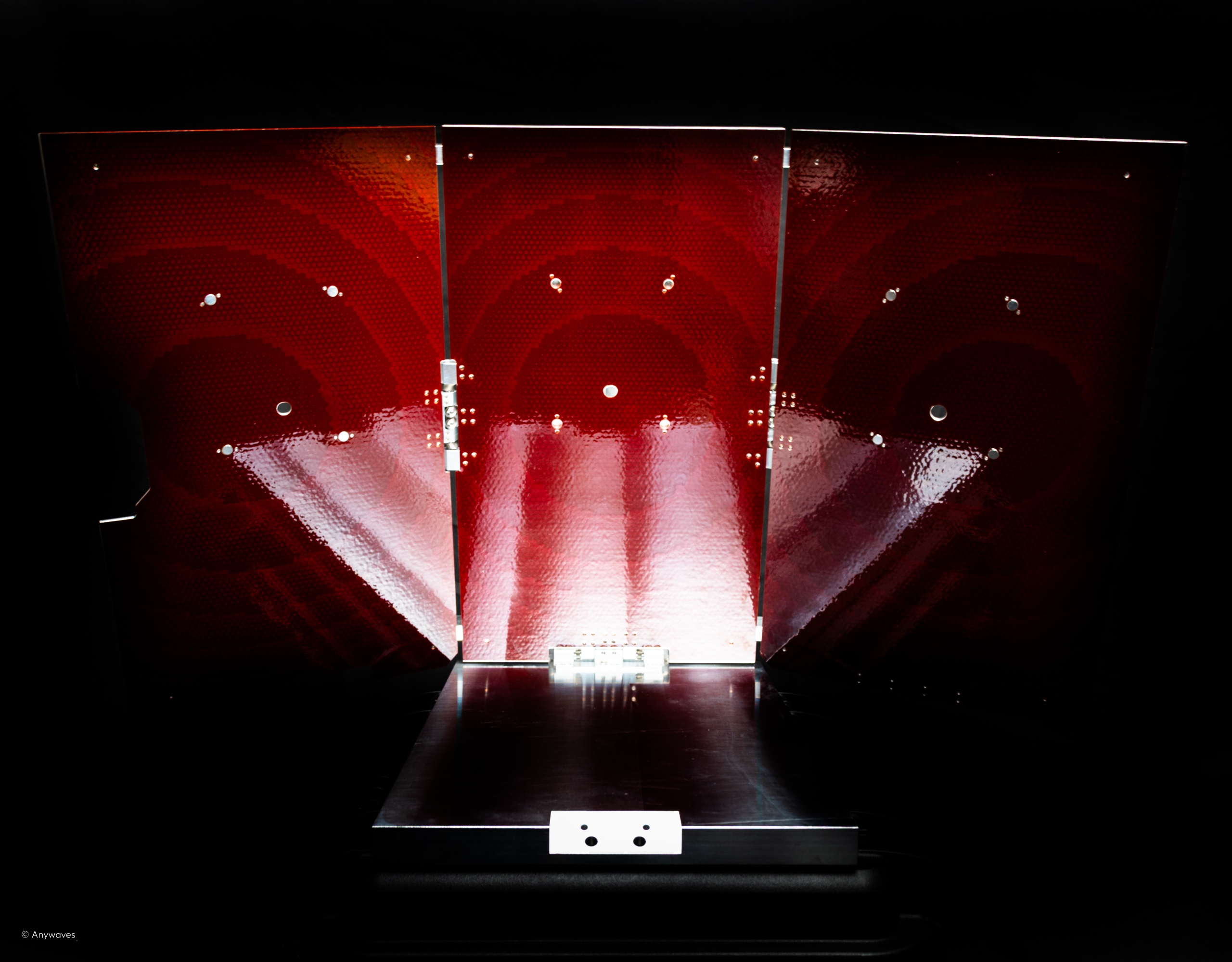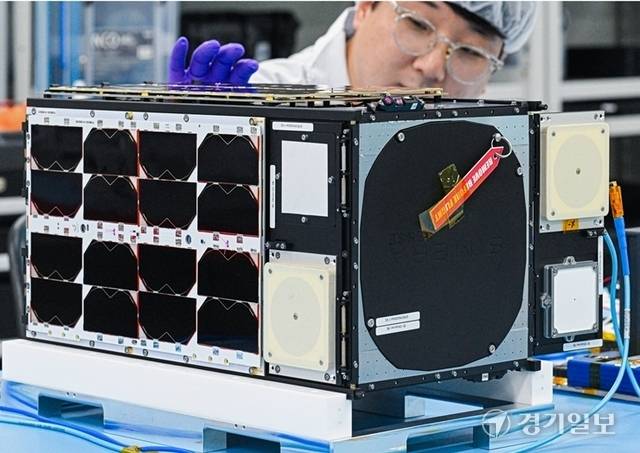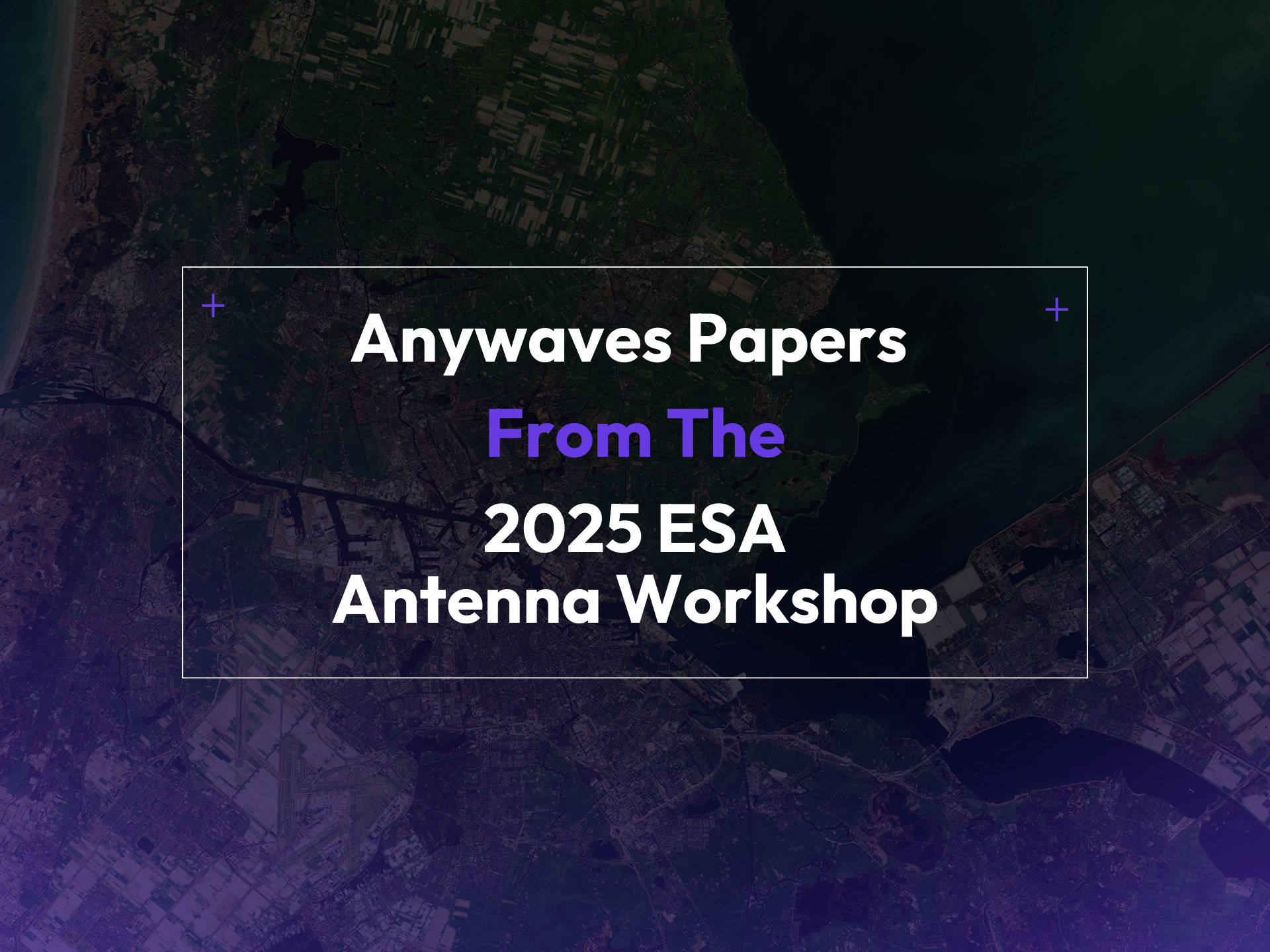Other news

Reflectarray Antennas for Small Satellites: From Concept to First Commercial Deployment
Read more
Case Study - GYEONGGISat-1: Enabling Climate Intelligence From Space
Read more
Welcome! This guide compiles answers to the most frequently asked questions about our antennas. We understand the importance of detailed information for your space mission, so we’ve covered topics ranging from our antenna models and testing processes to customization options and unique features.
Whether you’re an industry professional or exploring our products for the first time, we’re here to help you understand why Anywaves antennas stand out in the space industry. Dive in and find the answers you need!
If you can’t find the answer you’re looking for, please feel free to reach out to us through our contact page.
Our Engineering Models (EM) and Flight Models (FM) are constructed using similar high-grade materials and manufacturing processes to ensure electrical performance consistency. The key difference lies in their testing and intended use. EM antennas are typically used for testing and validation in a controlled, non-flight environment, serving as representative models for integration and functionality verification. In contrast, FM antennas undergo stringent acceptance tests and are certified for spaceflight. Additionally, FM antennas may include specialized coatings, such as anti-ESD radome paint for S-band TT&C, X-band Payload Telemetry, and GNSS All-band antennas, offering enhanced protection against space conditions.
For a more detailed explanation, you can read our article “What’s the Difference Between QM, EM and FM Antennas?“.
All Anywaves antennas are designed and manufactured in France with suppliers known for their expertise in space-grade components. This ensures high-quality production, rigorous standards of precision, and exceptional reliability for every antenna we deliver. Most of them are located in or around Toulouse, who is known as “the European Capital of Space“.
We accommodate orders of all sizes, whether you require a single Engineering Model (EM) for testing or a large volume of antennas. Delivery times depend on stock availability and project specifications, and we often fulfill orders within a matter of days. Contact us for tailored lead-time information based on your needs.
Yes, every Anywaves antenna comes with an Engineering Item Data Package (EIDP) to facilitate seamless integration and operational support. The EIDP typically includes:
We use space-qualified materials to ensure the reliability and durability of our antennas. For example, our slotted-waveguide antennas feature a full-metal construction that prevents electrostatic discharge (ESD) phenomena and provides thermoelastic stability. On our COTS antennas, we also use specialized coatings, such as anti-ESD radome paint, to further enhance durability and environmental protection.
Our antennas are designed to match or exceed the operational lifespan of their host satellites. For example, our COTS (Commercial-Off-The-Shelf) antennas used in LEO (Low Earth Orbit) missions are engineered to last a minimum of 8 years in orbit, with rigorous testing to confirm their longevity and durability even under challenging space conditions.
Our qualification testing ensures that Anywaves antennas meet the rigorous demands of space missions. The process includes:
If you need more information regarding our Testing Process, please refer to our dedicated page.
Our comprehensive testing protocol simulates harsh space environments to validate the durability and reliability of each antenna. As stated in the previous answer, this includes vibration, shock, thermal cycling, and radiation testing. By replicating extreme conditions, we ensure that our antennas maintain optimal functionality throughout their mission lifespan.
Flight models undergo essential acceptance tests, including:
To get full details on each step, please refer to the dedicated page.
Yes, our antennas are subjected to radiation testing to simulate the space radiation environment. This ensures they maintain functionality and structural integrity when exposed to high-energy particles.
Selecting the right GNSS antenna is essential for accurate navigation. Our GNSS antennas cover all major constellations (GPS, GLONASS, Galileo, BeiDou), ensuring reliable signal acquisition and precise positioning. Contact our experts to discuss your requirements, and we’ll guide you to the optimal solution. Alternatively, you can read our article “Why Do You Need to Cover All GNSS Bands with Your Navigation Antenna?” to get some additional insights on the topic.
Yes, our GNSS antennas are specifically designed for signal reception, providing highly accurate positioning data from global navigation satellite systems.
Our GNSS All-Bands antenna support all major constellations, including GPS, GLONASS, Galileo, and BeiDou, ensuring maximum coverage and positioning accuracy. Our GNSS E1/L1 Antenna and our Ceramic 3D Printed E1/L1 Antenna operate in the GPS L1 (1563-1587 MHz) and Galileo E1 frequency bands.
Telemetry, Tracking, and Command (TT&C) antennas are selected based on mission-specific criteria such as frequency range, gain, beamwidth, and mechanical constraints. If you want an antenna with a strong flight heritage, our flagship S-Band Antenna is the one to choose. If you have space constraints or need dual-circular-polarization, our Compact S-Band Antenna will be a more appropriate solution. If you need a reliable Ka-Band antenna, our Choke Ring antenna is ideal for you. In any case, our experts will help you choose a suitable antenna tailored to your communication needs.
Yes, our TT&C antennas are dual-purpose, enabling both reception of telemetry data from the spacecraft and transmission of control commands from ground stations. This capability ensures effective, continuous communication for critical mission operations. Learn more about our range of TT&C antennas, including options for S-band and Ka-band applications, on our product page.
Our TT&C antennas provide wide-beam radiation patterns, ensuring robust communication links with spacecraft, even under challenging conditions. Operating within key frequency bands such as S-band and Ka-band, they are built with high-quality materials to endure extreme mechanical stress, temperature fluctuations, and environmental factors encountered during launches and extended operations in orbit. For more details on our TT&C solutions, please visit our TT&C product page.
ANYWAVES TT&C antennas operate in either S-band and Ka-band frequency ranges, providing dependable telemetry and control capabilities that can be tailored to the specific needs of space missions. These frequency bands are selected for their optimal balance of range, data rate, and resilience against interference.
Choosing a suitable Data Downlink (X-Band) antenna involves evaluating your mission’s data transfer rate requirements, bandwidth needs, beamwidth, mechanical constraints, and environmental conditions. Our team offers personalized recommendations based on your specifications to ensure seamless and efficient data transmission for your payloads. Learn more about our X-Band Data Downlink antennas here.
Anywaves’ Data Downlink antennas are primarily designed for data transmission, allowing high-speed data transfer from the spacecraft to ground stations. However, they are engineered to operate in reception mode when needed, providing flexibility for unique mission requirements.
Our Data Downlink antennas are characterized by high data transfer rates, increased bandwidth capabilities, compact design, and robust construction to withstand the harsh conditions of space. This makes them ideal for payload telemetry and efficient data transfer, even in challenging mission environments.
Our Data Downlink antennas are optimized for the X-band frequency range, ensuring high-speed and efficient data transmission for payload telemetry and mission-critical data exchanges. They are available in either Left or Right-Hand Circular Polarization, and if you need a Dual-Circularly Polarized Antenna, you should check our latest X-Band Antenna.
At Anywaves, we recognize that each mission may have unique requirements. We offer a full suite of customization services, including the modification of existing designs or the creation of entirely new antenna solutions tailored to your specifications. Our engineering team works closely with clients to design solutions that align with mission objectives, ensuring optimal performance, reliability, and compatibility.
Anywaves excels at developing a diverse range of custom antennas, such as high-gain models for telecommunications, inter-satellite links, and payload telemetry, as well as wideband antennas for spectrum monitoring, GNSS applications, and LEO Positioning, Navigation, and Timing (PNT). We also specialize in integrated and active antennas to meet specific functional and mechanical requirements. Explore more about our custom solutions on our custom antennas page.
Yes, our antennas are designed with flexibility in mind, allowing for scalability and performance adjustments to meet mission-specific requirements. Whether you need customized gain, beamwidth, frequency range, or other parameters, we can tailor the design to align with your exact needs. This ensures that your antenna solution is optimized for maximum efficiency and mission success.
Absolutely. Our integrated antennas- such as our GNSS All-Bands with LNA card – reduce RF losses and optimize onboard RF power by incorporating RF front-end circuitry directly into the antenna chassis. We collaborate closely with clients to ensure seamless integration with payload modules, addressing size, mechanical, electrical, and thermal constraints for optimal performance.
Our spatial and launcher antennas are tailored to address different needs within the satellite industry. Spatial antennas are crafted to support satellite communication functions, including data downlink and payload telemetry. Conversely, launcher antennas fulfill a distinct role by providing reliable communication and tracking throughout the critical ascent phase. These antennas are built to endure the extreme environmental conditions and vibrations during launch. They are also optimized for ground-based operations, facilitating essential telemetry and tracking.
Launcher antennas are uniquely crafted to fulfill the specific demands of the launch phase in space missions. They exhibit several critical features, including:
You can find more information on our dedicated Launcher Antennas page.
Yes, we offer Test Caps designed to facilitate accurate testing and verification of launcher antennas during integration and development. Our Test Caps allow for controlled and efficient testing, streamlining the validation process and minimizing operational costs.
A test cap (or test hat) is a ground segment device that enables end-to-end RF testing directly on your satellite, eliminating the need for anechoic chamber tests. This controlled RF environment streamlines testing processes, offering consistent and reproducible measurements while reducing costs. To get additional information, you can check our Product Page or read this piece of content: Why you should use Test Caps to revolutionize your testing process.
Test caps simplify antenna testing by providing consistent measurements in various environments, including cleanrooms and thermal chambers. While they reduce dependency on anechoic chambers, compatibility is critical: our test caps are specifically designed for Anywaves antennas. Due to design variations among other manufacturers, we cannot guarantee compatibility with non-Anywaves antennas.
Thank you for exploring our comprehensive FAQ guide: We hope it has provided you with valuable insights into our product capabilities, testing standards, and tailored solutions. Whether you need We hope this FAQ compilation has provided you with valuable insights into ANYWAVES antennas, our design capabilities, testing standards, and customized solutions for space missions.
Our commitment to excellence ensures that you receive antennas optimized for precision, durability, and reliability. If you have further questions or specific project needs, don’t hesitate to contact our team for personalized support!



If you have any question, we would be happy to help you out.